We celebrated our first full year of life on our homestead in May! We left urban Cambridge, MA to chart a wholly different life out here on 66 acres in rural Vermont and the change this represents for us is nothing short of transformational, radical, and miraculous. Neither Mr. Frugalwoods nor I grew up–or ever lived–in a rural setting before moving here and so this year was one of constant learning and exploration (not to mention mistakes), a combination that suits us perfectly.
Why We’re Out Here
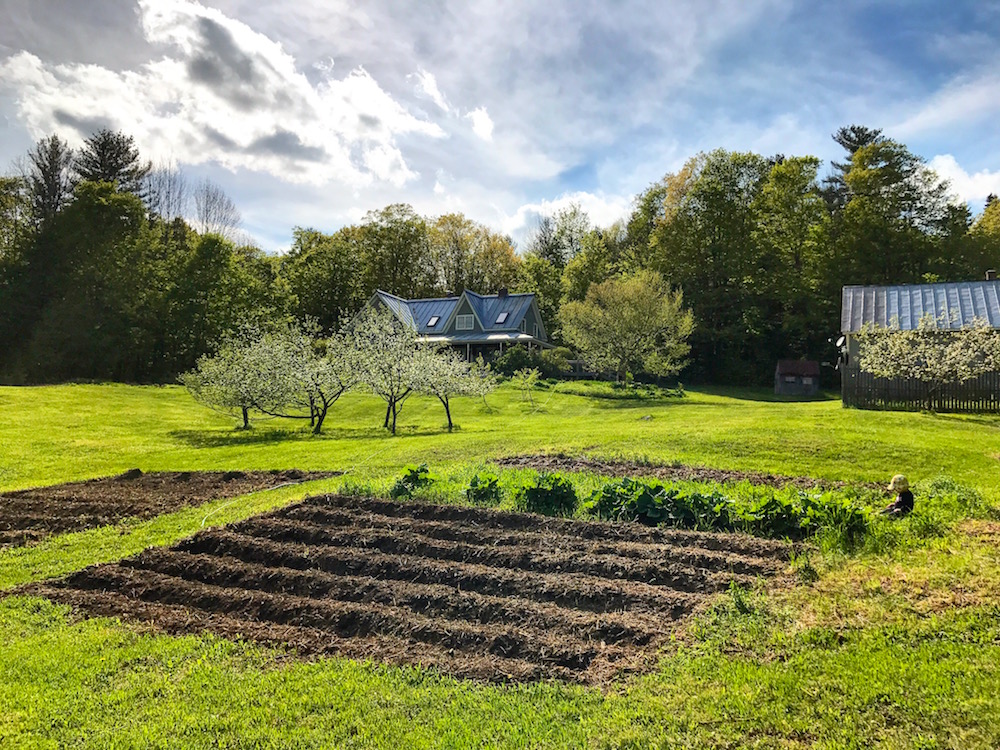
Mr. FW and I both crave adventure and diversity to our days and the opportunity to explore our land and uncover all the things we don’t know about homesteading invigorates us. One of the reasons we wanted to move out here is that after living in cities for ten years–NYC, Washington, DC, and Cambridge, MA twice–we felt tapped out. We were done with city life.
We both grew up in the suburbs and for us kids of cul-de-sacs and minivans, the city was an exotic locale where we could reinvent ourselves. We could shed our quotidian upbringings and become sophisticated urbanites. Taking the subway for the first time, learning to walk everywhere, and availing ourselves of the endless free culture was exhilarating. Over the course of ten years, we transmuted from midwestern kids into east coast professionals. We loved city life and we lived it to the fullest. Now we’re performing that reinvention yet again.
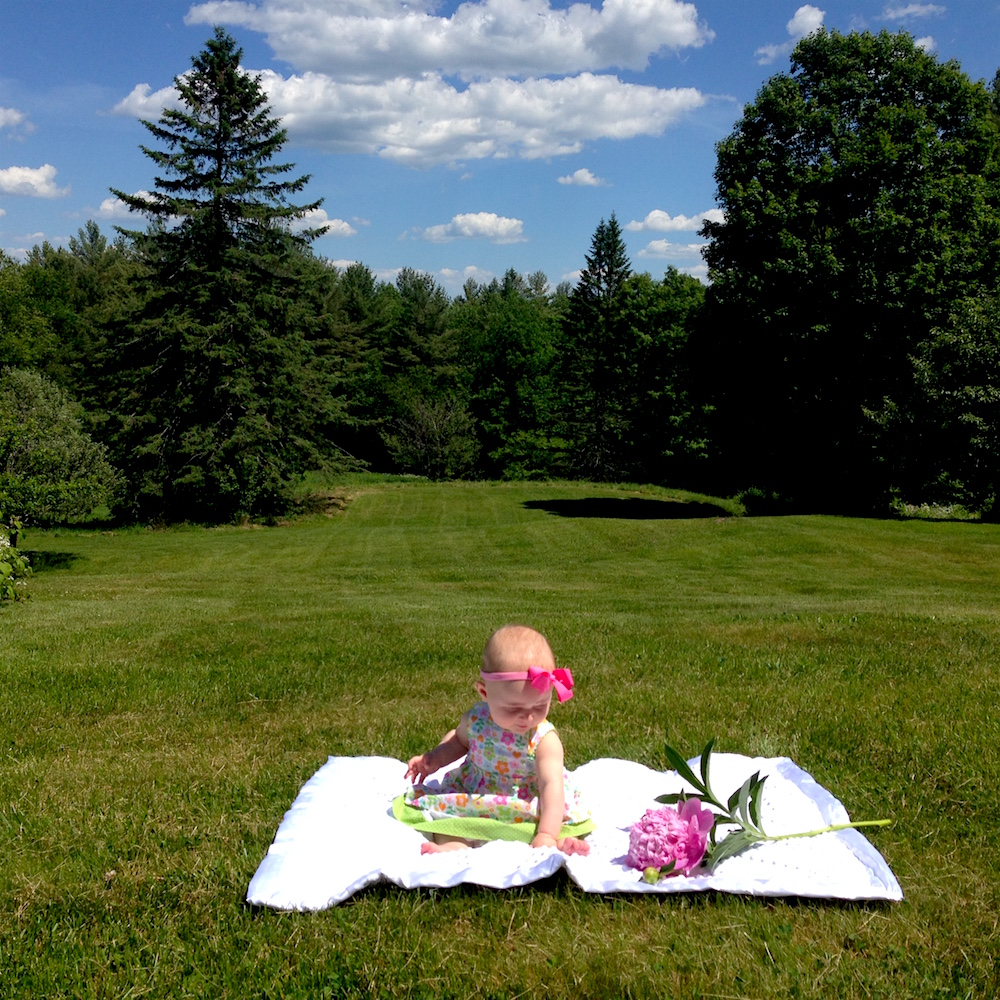
We reached a point at which the stuff we didn’t like about cities–the crowds, the dirt, the lack of nature, the cramped living quarters, the expenses, the hectic and pressured pace–overtook the pros. There was a tipping point for us at which we were no longer willing to put up with the cons, which heralded in our Frugalwoods plan. The short version of this plan: we decided city life wasn’t fulfilling us, so we saved over 70% of our income in order to decamp to the woods and reach financial independence. In the process, we turned our Cambridge, MA home into a rental property.
If you’re interested in more background on our decision, I’ve shared our thinking on why we made this move in the following posts:
- How We Decided Our Homestead Was The One
- That Time We Bought A Homestead
- Frugal Homestead Series Part 3: Why Vermont?
- The Frugal Homestead Series Part 1: Why The Woods?
The 7 Best Moments From Year One
I’ve documented each month of our first year in my This Month On The Homestead series and so today, I’ve put together a rundown of our best and worst moments. Let’s start with the bright side!
1) Bearing witness to the progression of the seasons.
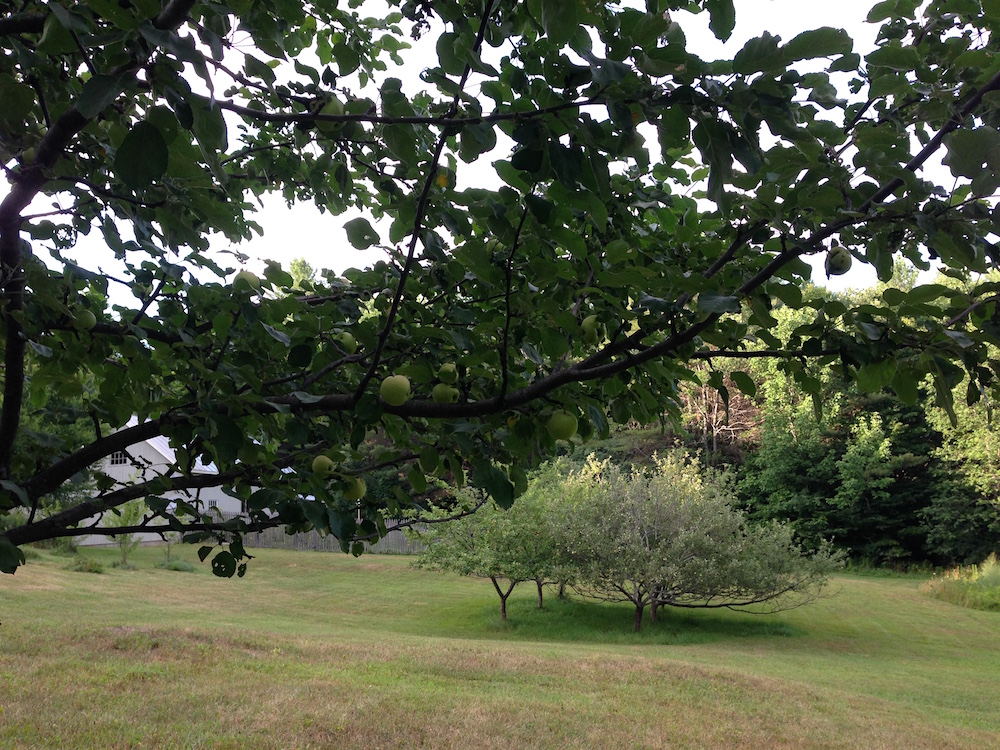
Vermont does seasons like Elvis does rock-n-roll, which is to say: textbook. It’s an all caps situation for each of the four–there’s really no half-way around here. In winter, it is ALL SNOW, all the time. Spring is a shoulder season of tentative blossoms that find their footing and take over the landscape. Summer encapsulates a North American rainforest and the speed of plant growth is unfathomably fast (especially weeds… ). Fall heralds every conceivable leaf hue with crunching, crackling, crisp apples, and cider.
I’ve never lived anywhere with such stereotypically idyllic seasons. And I love it. One of the reasons we chose Vermont was the weather and this dramatic swing from season to season. In the wintertime, when snow blankets the earth rendering it a solid, unbroken plane, it’s impossible to remember that we’re snowshoeing over ridges of shrubbery and garden beds. Likewise, the riot of green and sunshine that drenches our land in the summertime obliterates our memories of snow’s stark precision.

In fact, Vermont is so obsessed with seasons that we have two more seasons than anyone else: stick season and mud season. Stick season is an autumnal occurrence that graces us post-leaves and pre-snow. The name derives from the bare, angular trees that glare at you at every turn. Mud season is the springtime equivalent of stick season: all the snow has melted but nothing is green yet. The name derives from the fact that everything is atrociously muddy.
My photographs from these two shoulder seasons are almost indistinguishable from one another and it’s a bizarre time of year where seasonality feels suspended–it’s neither hot nor cold and the trees offer no indication of which direction they’re headed in: have they just finished or are they just about to begin?
2) Eating food from our garden.
This never gets old. Not only is it frugal, it’s also miraculous. Stuff grows straight out of the dirt and then… we eat it! Could I sound more like a city person? Closing the loop on our food sources is a mega, lifelong goal of ours and we think/hope we’re making progress in this arena.
Gardening represents our steepest learning curve since it’s a lot (MASSIVELY) less straightforward than we imagined and it’s something we really (REALLY) want to excel at. Soil, rain, heat, cold, animals, weeds (f-ing weeds), the way the wind blows, whether or not Babywoods accidentally tramples plants… all of this plays into our ability to grow our own food and, let me tell you, we’ve not been terribly successful thus far. Our growing season is short–we’re in zone 4a–and although we started a bunch of veggies from seeds indoors this year, they’re not doing terrifically out there so far. More on our gardening adventures here, here, and here.
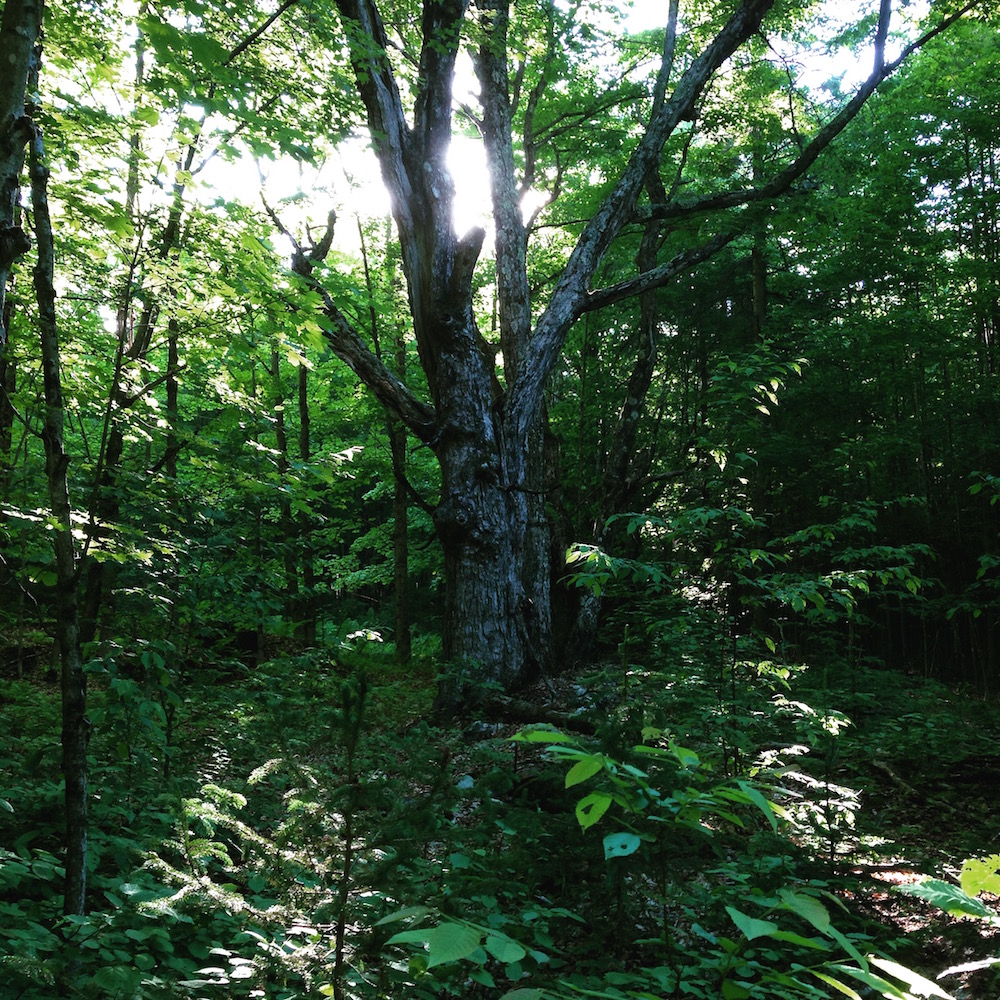
Whoops, just realized this is supposed to be the “bests” section, so let me share our wins: asparagus, arugula, rhubarb, apples, chives, blackberries, black raspberries, and approximately five tomatoes. Fingers crossed this summer’s bounty will exceed!
Our ultimate vision is to grow so many vegetables that we eat off them all year round via preserving, freezing, and canning. At this rate, I estimate we might be there in another four to forty years or so.
3) Preserving (some) food.
Since we did grow more than we could consume last summer in the categories of rhubarb, blackberries, black raspberries, and apples, I am profoundly proud to say that we managed to preserve some of these foodstuffs. Don’t be too impressed though, we followed the easiest/laziest methods of preservation:
- I made rhubarb compote, which we froze in serving sizes and which I thaw to put atop homemade pound cakes for potlucks and parties. Frugal tip: no need to buy strawberries to add in, the rhubarb + sugar is plenty sweet and flavorful!
- We froze blackberries and black raspberries and have been enjoying those all year on salads, oatmeal, and yogurt, or solo as Babywoods prefers them.
- We dehydrated a slew of apples and froze those as well. These thaw out perfectly and make a wonderful baby (+ momma) snack. The dehydrator we purchased for this express purpose was well worth the cost! And, three frugal cheers for the apple peeler/corer I found by the side of the road in Somerville, MA three years ago (I KNEW we were going to need that thing one day!).
4) Our community and friends.
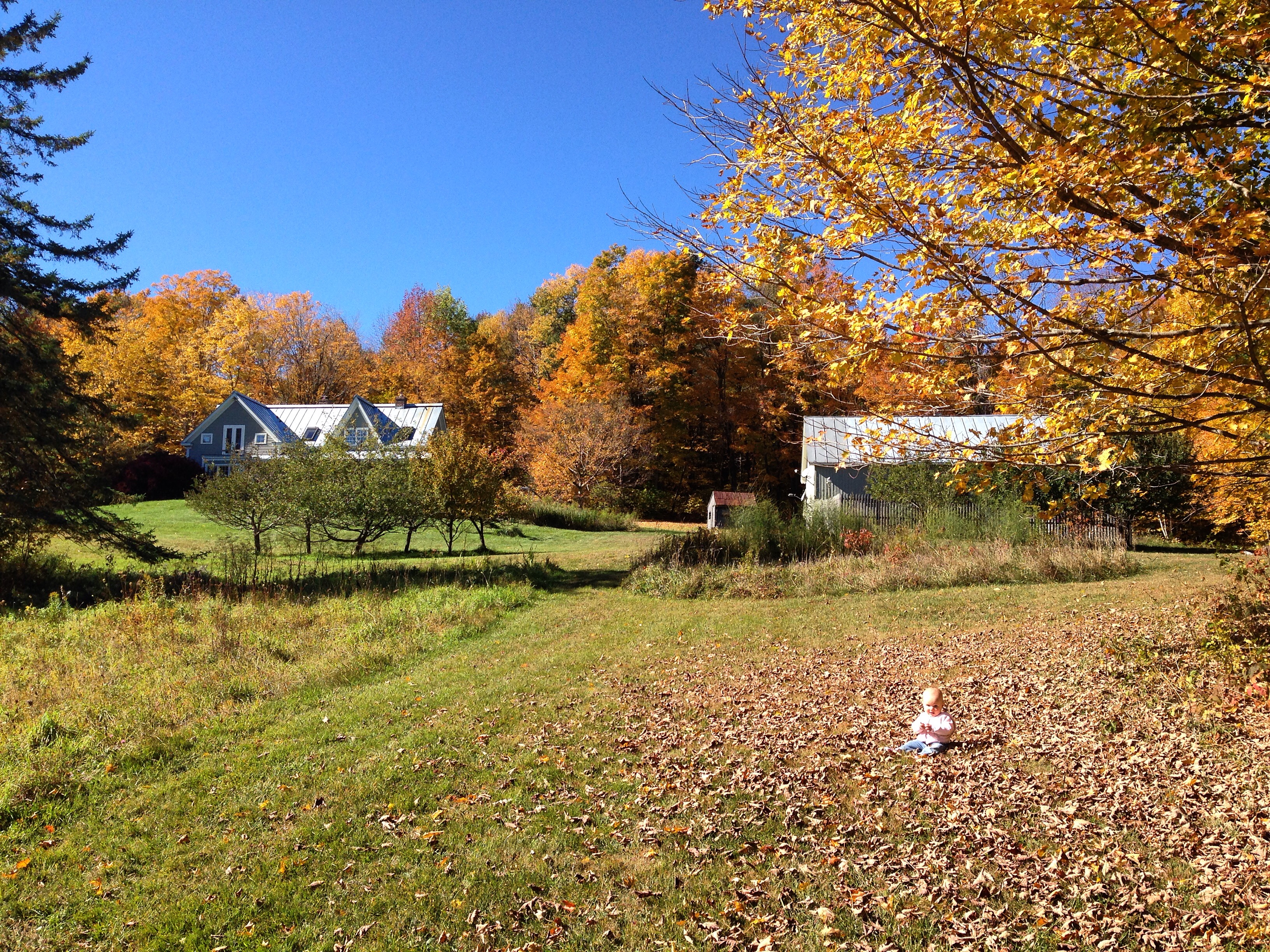
I’ll be honest, before we moved here, I was pretty worried about finding friends. We’re in a town of 400 people, in the middle of deep woods, with our closest neighbor a quarter mile away. Quite the change from our previous iteration of life where our next door neighbor’s house was a mere ten inches from ours.
But my fears of isolation turned out to be wholly unfounded. Our community is tight-knit yet welcoming to us newcomers, there’s a slew of young parents with kids close to Babywoods’ age, and we find ourselves blessed with more social opportunities than we can handle.
There are town potlucks, church potlucks, birthday party potlucks, winter potlucks, summer potlucks, not to mention town fairs, gatherings every Saturday, baby play groups, and more. As you might’ve guessed, everything out here is a potluck, which suits us frugal weirdos just fine. Our town doesn’t have a movie theater or a mall or even a restaurant (although we do have a town pizza oven!), but that doesn’t preclude folks from hanging out. The mantra I’ve touted for years–that friendships aren’t destroyed, but rather are enhanced, by frugality–is what our neighbors have practiced for decades.
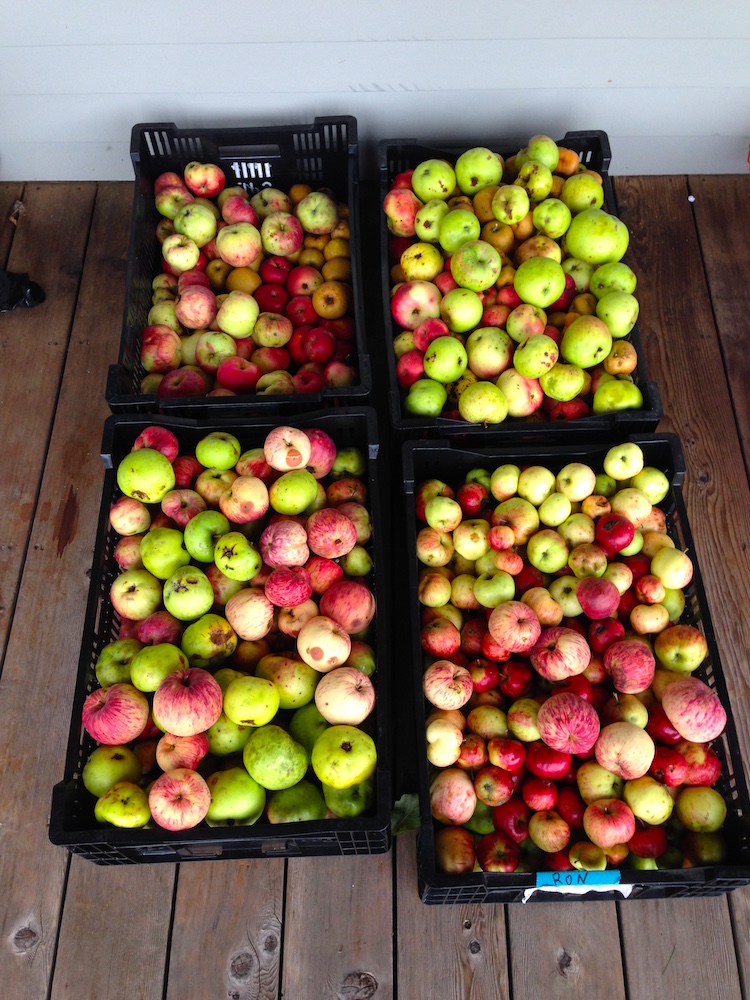
We’ve learned the art of barter and trade, the art of helping your neighbor, and the art of accepting their help in return. We feel more connected and more deeply engaged with the inter-generational community we’re part of here than we did in any city we ever lived in. Although surrounded by people in an urban environment, we lacked this notion of community, this knowledge that in the absence of commercial solutions, you can–and should–depend on your neighbors.
5) The pace of our lives.
Perhaps the most profound impact of this past year is the change that rural life brought to our little family. Without commutes, without the stress of the city, and without the pressure to keep up/impress others/own a bunch of stuff, we’ve been able to decompress.
Our days follow a laid back pace–we get a lot done, but it’s in our own time and in our own space. We never set an alarm clock (Babywoods takes care of that for us). We go to bed early because we do best with lots of sleep. We don’t watch much TV because we do best with quiet. We don’t have a lot of stuff because we don’t do well with clutter. Some days we don’t leave our property because we’re homebodies.
We’re crafting a life that works for us–not one that’s popular or represented in the media or touted as ideal–and many folks might consider it simple or perhaps even boring. But it works for us and it makes us happy. Finding contentment on a daily basis was a central focus of making this move. Prior to leaving the city, every day felt like a strain for me–I was always striving for something, grasping for accomplishment, trying to impress people–and I wasn’t ever content or settled in what I did.
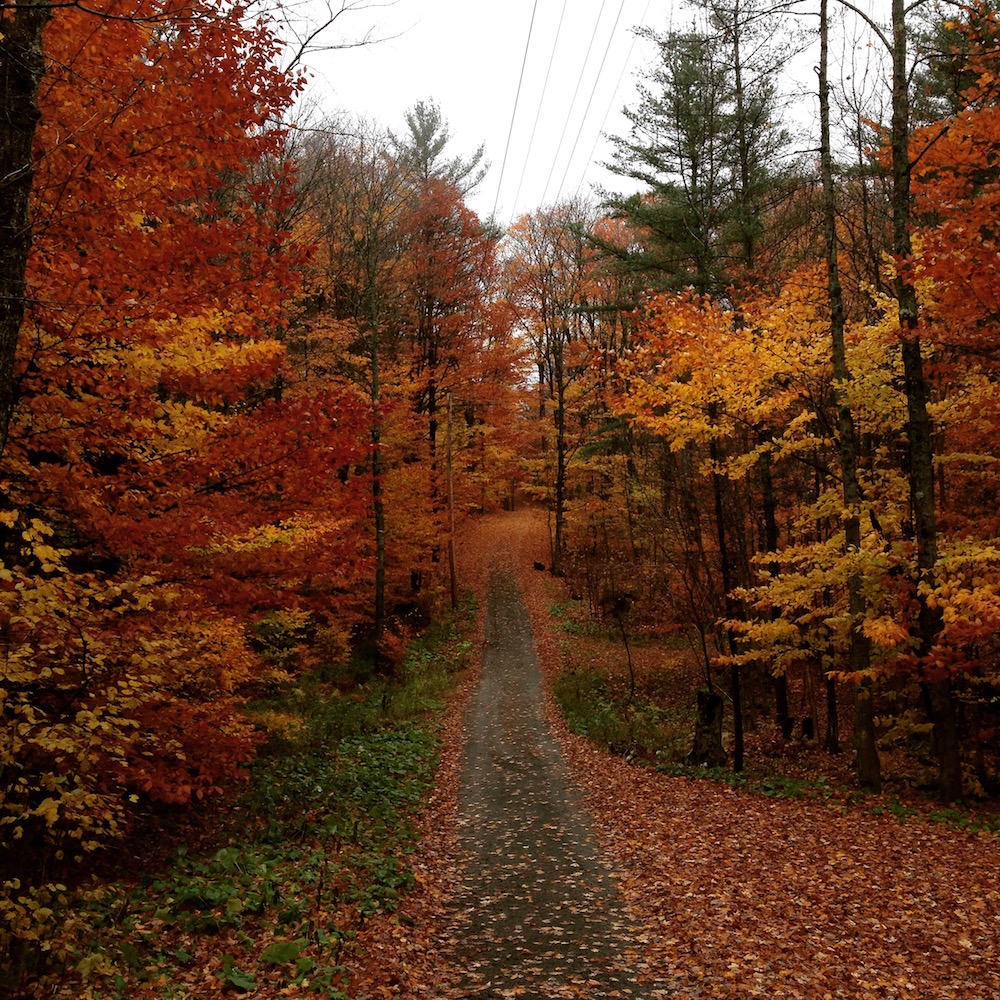
Now, finding peace in the present moment is my daily ritual. It’s an imperfect, evolving process that changes with each season–and each stage of Babywoods’ development–but it’s one that I look forward to living for decades to come. The ability to do work that’s meaningful to me from home, while hanging out with my husband and daughter, is the epitomization of my dreams.
6) Hiking in all weather.
I marvel at our ability to hike on our land every single time I step foot outside. We are beyond fortunate to live on 66 acres of mostly forested landscape, with streams, a pond, apple trees, plum trees, gardens, and alcoves of ferns. Mr. Frugalwoods built–and is in the process of building more–hiking trails that bisect our property.
With no barrier to entry, I hike every single day, except when we’re sick or it’s pouring rain–although we did hike in the rain the other day and it wasn’t too bad. We hike all winter long, pulling Babywoods behind us in a sled, bundled up in blankets, over the whipped cream folds created by snowfall after snowfall.
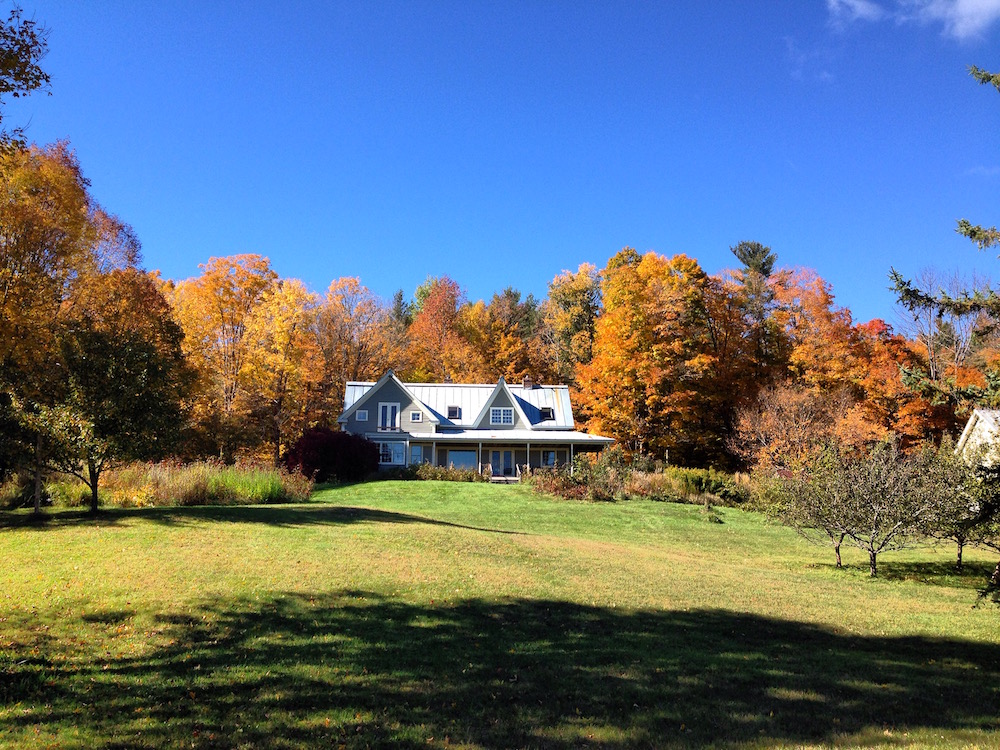
We hike all summer, pushing Babywoods in our $5 thrift store jogging stroller, navigating streams, logs, and branches with ease. Every single time I hike in the woods, I’m transformed. I forget this magic from day to day and sometimes I dread the hassle of getting everyone dressed and ready to leave the nest of our home. I have to wrangle baby feet into shoes and a baby head into a hat, but within minutes on the trail, I can’t believe I considered not coming.
Nature is a balm for me, a way of easing my mind, of lowering my blood pressure, of re-focusing my priorities. The bonus is that it’s an instant baby mood-enhancer. If Babywoods is having a rough day, there’s no better amelioration than a walk in the woods.
7) The coziness of our home.
I love our house. It’s imperfect in its rendering, but it’s perfectly suited for us. We snuggle by the woodstove all winter and we loll on the porch when it warms. This home is ideal for our family and it brings me joy. I experience a sense of relief when I drive down our driveway returning from a trip away, no matter how short. I’m always glad to be home.
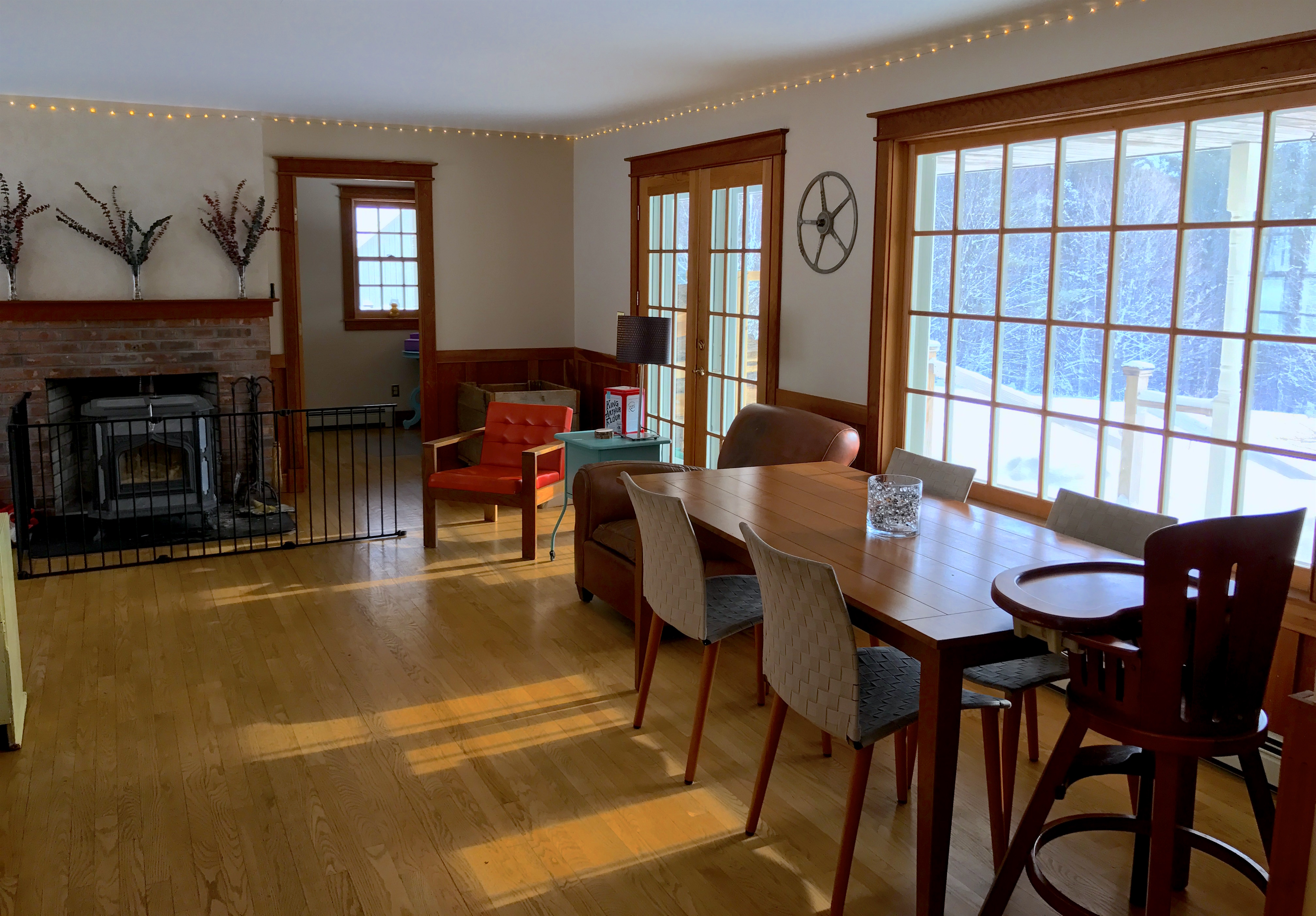
We have yet to do a single thing to the interior of this home–we haven’t even patched holes or painted–but it’s ours nonetheless. There’s no need to renovate or redecorate or pour thousands of dollars into cosmetics in order to love where you live.
One day perhaps we’ll do away with the ’90s-era sponge painting above our fireplace and replace the green plastic kitchen countertops, and patch the inordinate number of gouges and holes in every wall, and install overhead lighting in the family room (and take down the Christmas lights that currently brighten that room), but for now, it’s our domain and we are content.
The 4 Worst Moments From Year One
No one’s life is perfect–least of all mine–so I want to share a few of our worst moments from this past year. Not to complain, not to whine, and not to wish for anything different, but to acknowledge that we’re able to find happiness despite these imperfections.
1) Realizing how much stuff we need to buy.
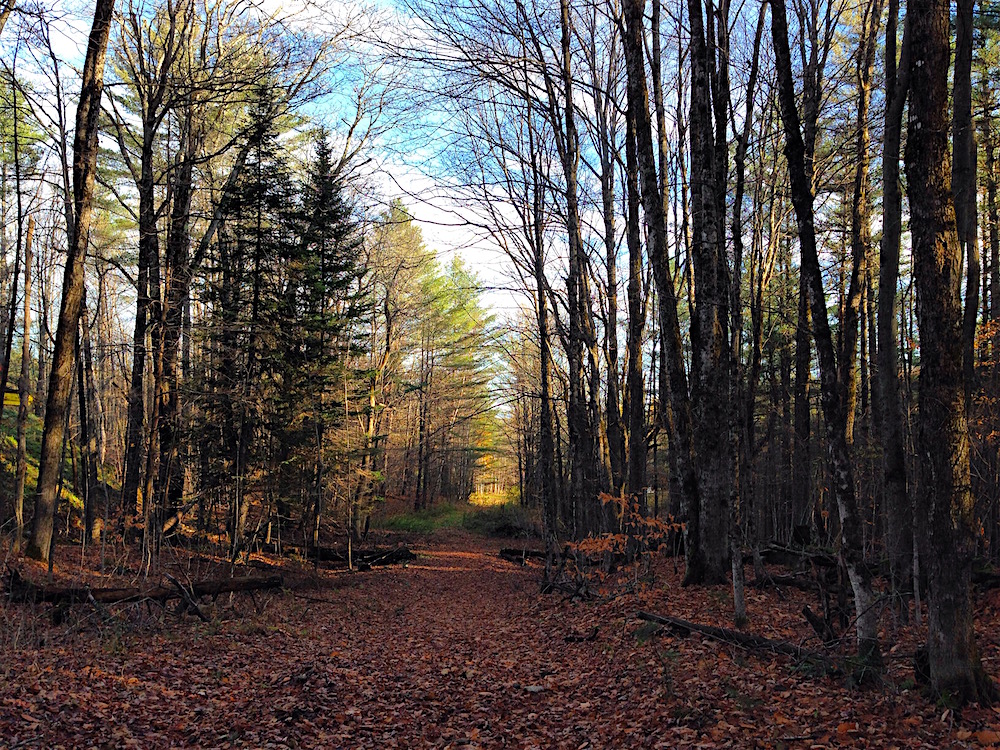
Before moving here, we knew we were going to need a bunch of stuff in order to equip our homestead, but the list just keeps growing. Fortunately, we anticipated a year of slightly higher spending and so it hasn’t thrown off our projections or savings rate.
There’s a profound difference in equipment needs when one transitions from from urban to rural life. We didn’t own so much as a rake back in Cambridge since our house was surrounded by 100% concrete. Lucky for us devoted purchasers of used stuff, there are a bevy of garage sales, flea markets, Craigslist, and thrift stores out here, which’ve eased purchase prices.
We initially borrowed some of these items from neighbors, but the problem is that when we need to use a chainsaw? Everybody else needs to use their chainsaw too! For specialized equipment that we’re likely to use only once, we try to borrow from friends. But for items we use over and over and over again, week after week after week… we need to own our own.
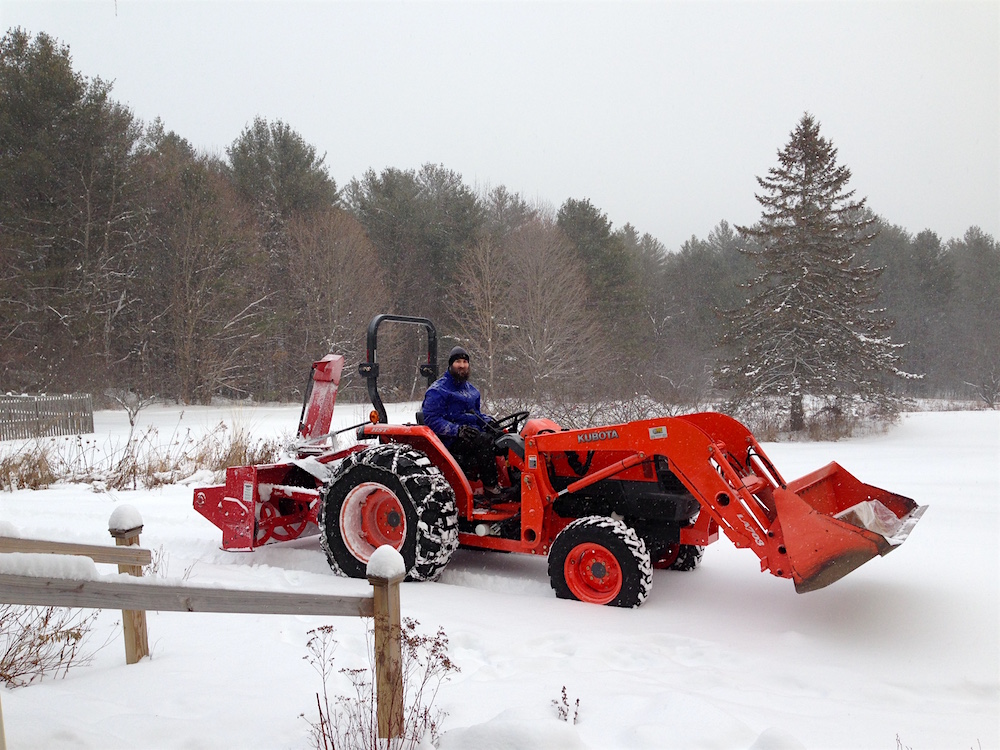
In the long run, these purchases will yield greater frugality as they enable us to DIY all of the work on our land. For example, since we own our own tractor, which has a snowblower attachment, Mr. FW clears our quarter mile long driveway himself. If we had to hire someone to do this every single time it snowed (and sometimes twice per storm), we’d be out $65 every plow. Mr. FW estimates he cleared our driveway at least 25 times this winter, which’d be a whopping $1,625 for just one measly winter!!!
And in the summertime, that same tractor gets put to work tilling garden beds, grading the driveway, hauling logs, brush hogging trails and fields, and more. The additional bonus–beyond saving money–is that we’ve learned how to do all of this stuff ourselves (through trial, error, consultations with neighbors, and lots of tractor YouTube videos of which there are a plethora… ). If we hired someone, we’d never learn these skills ourselves. Despite these longterm advantages, in the short term it’s a pretty extensive range of expenses!
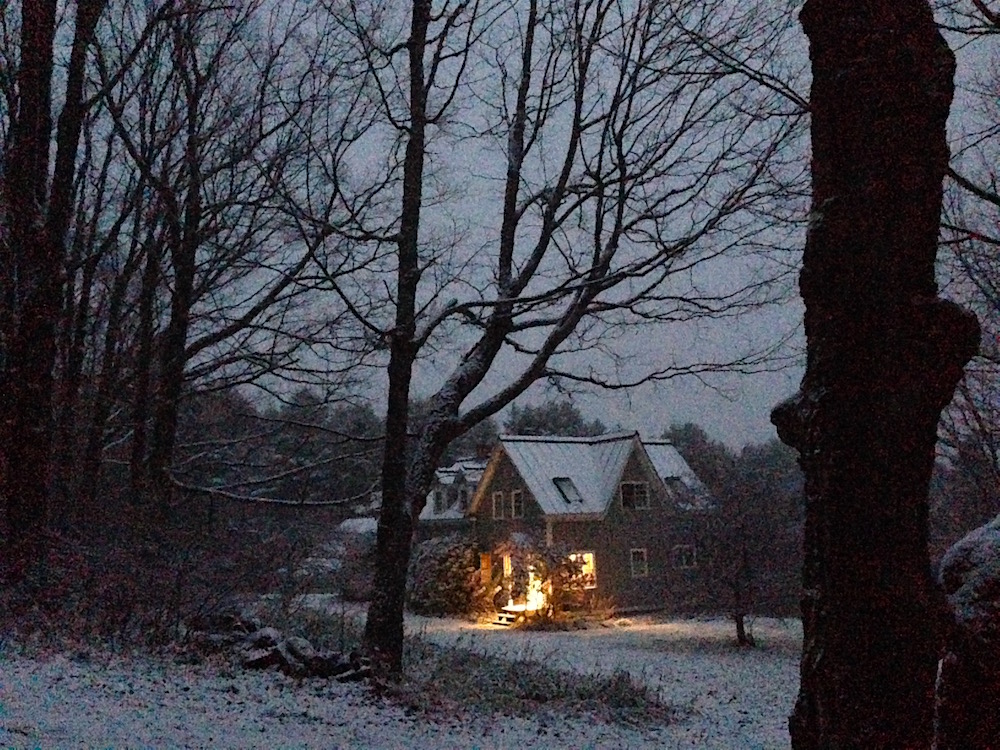
Here’s but a small sampling of the things we’ve had to purchase:
- A tractor (this was included in the purchase of our house, but still… ), which allows us to clear snow from our quarter-mile long driveway, till garden beds, brush hog trails, grade the driveway, and more.
- A large lawnmower.
- A chainsaw and chainsaw safety gear, which allow Mr. FW to fell and buck trees for firewood to heat our home, clear fallen trees off our driveway, and build hiking trails.
- An axe and a maul for splitting logs into firewood.
- This dehydrator to dry our apple crop.
- Canning supplies to preserve food.
- A plethora of garden tools: rakes, hoes, trowels, a post-hole digger, a wheel barrow, etc.
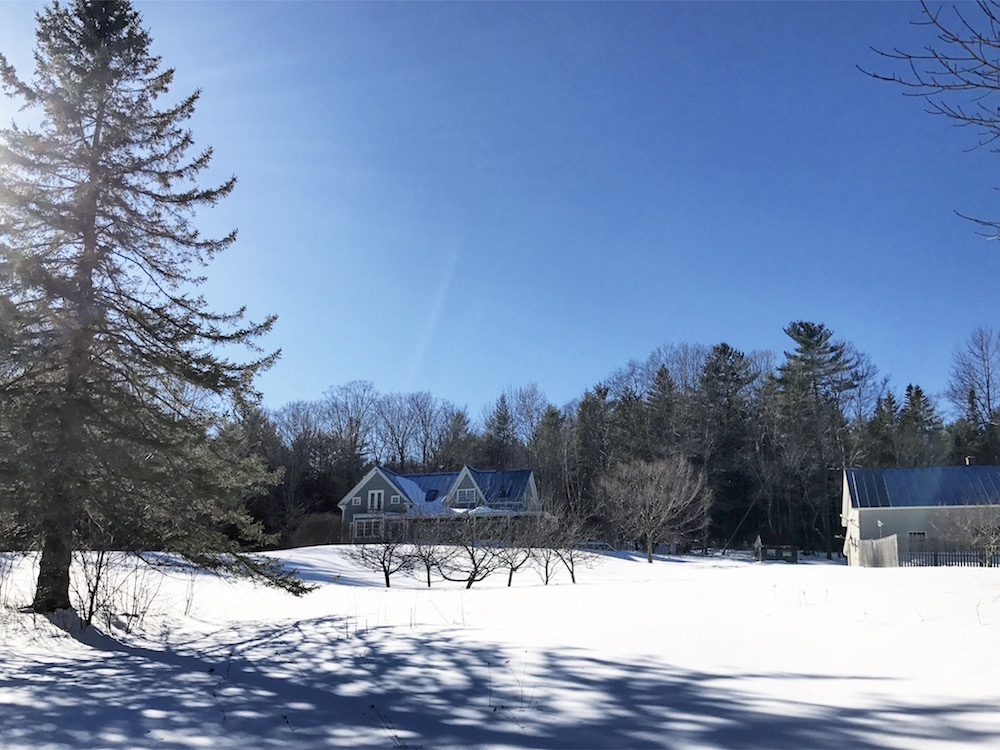
Sidenote: for dedicated readers of our monthly expense reports, these items usually show up in the category of “household and farm supplies,” unless I list them individually.
2) Getting stung by a wasp (and bugs in general).
Last summer in a valiant (but ultimately failed) attempt to clean several active wasp’s nests out of our potting shed, Mr. FW was stung in the neck. Not cool. Bugs are part of life out here in the woods and we’re becoming increasingly acclimated to their presence in our lives.
We conduct thorough tick checks on every member of the family each evening in the summer, we use screens on our windows, and our trusty fly swat is always at the ready. However, bugs have a more enhanced presence in our lives that I’d, ahem, prefer.
3) Not being prepared for ripe apples.
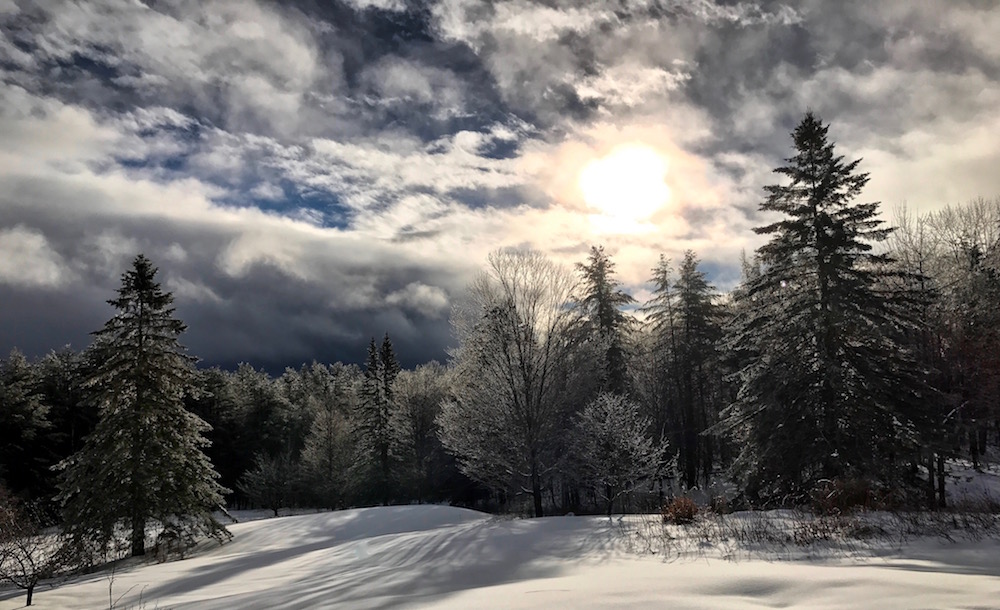
We learned last August that we’re the proud owners of an early ripening apple tree–a Red Duchess! Hence, all of a sudden we had about 9,000 ripe apples long before we expected them.
We hastily bought this dehydrator to try and process as many of them as possible, but we need a system capable of handling a larger quantity of apples. Our plan is to purchase a cider press (see item #1… ) in order to make hard cider this fall. Yum! And yes, I tried diligently to borrow a cider press last fall, but everyone was busy pressing their own apples!
4) Learning how to say no and manage our time.
Since a central goal in moving out here was to embrace a slower, less stressful mode of living, we’ve had to learn how to pace ourselves. There’s a temptation to work outside late into the evening and cram our days with an endless, ceaseless tide of homestead chores and activities, but we can’t. Not if we want to maintain equilibrium and incorporate rest into our days. Consequently, we’ve had to become comfortable with a lot of undone things.
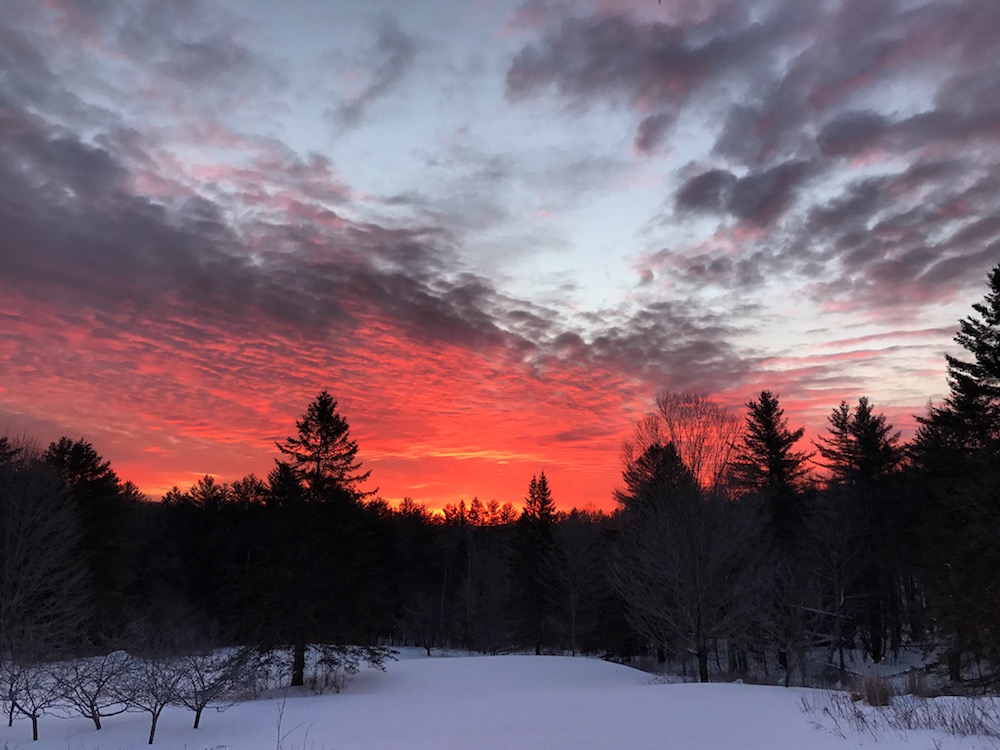
Back in the city, it was pretty easy to knock off an entire to-do list in a weekend. Out here? On 66 acres? Our to do lists will range for years. And that’s OK. Coming to a place of acceptance with the undone is an ongoing process for us Type A go-getters. We want to do it all right away, but we can’t. Rather than tie ourselves into knots of stress, we’re trying to have grace in admitting we’re unable to accomplish everything.
Parallel to this is our desire to be involved in our community. Mr. FW serves on the boards of two different nonprofit organizations and is a volunteer steward with the Land Trust. I volunteer for our church and a community organization, primarily from home doing editing, writing, and poster making.
There’s so much more that we both want to do with our friends and neighbors, but we have to acknowledge the limits on our time: we’re stay-at-home parents to a toddler, we work on our land, and we work what I call “computer jobs” from home. We choose to balance our lives in this way and we love the diversity of our days–typing at a screen one hour, harvesting rhubarb the next, playing with Babywoods in the garden another–but it mandates that we manage our time carefully and ruthlessly prioritize what we do.
Our Hopes For Next Year
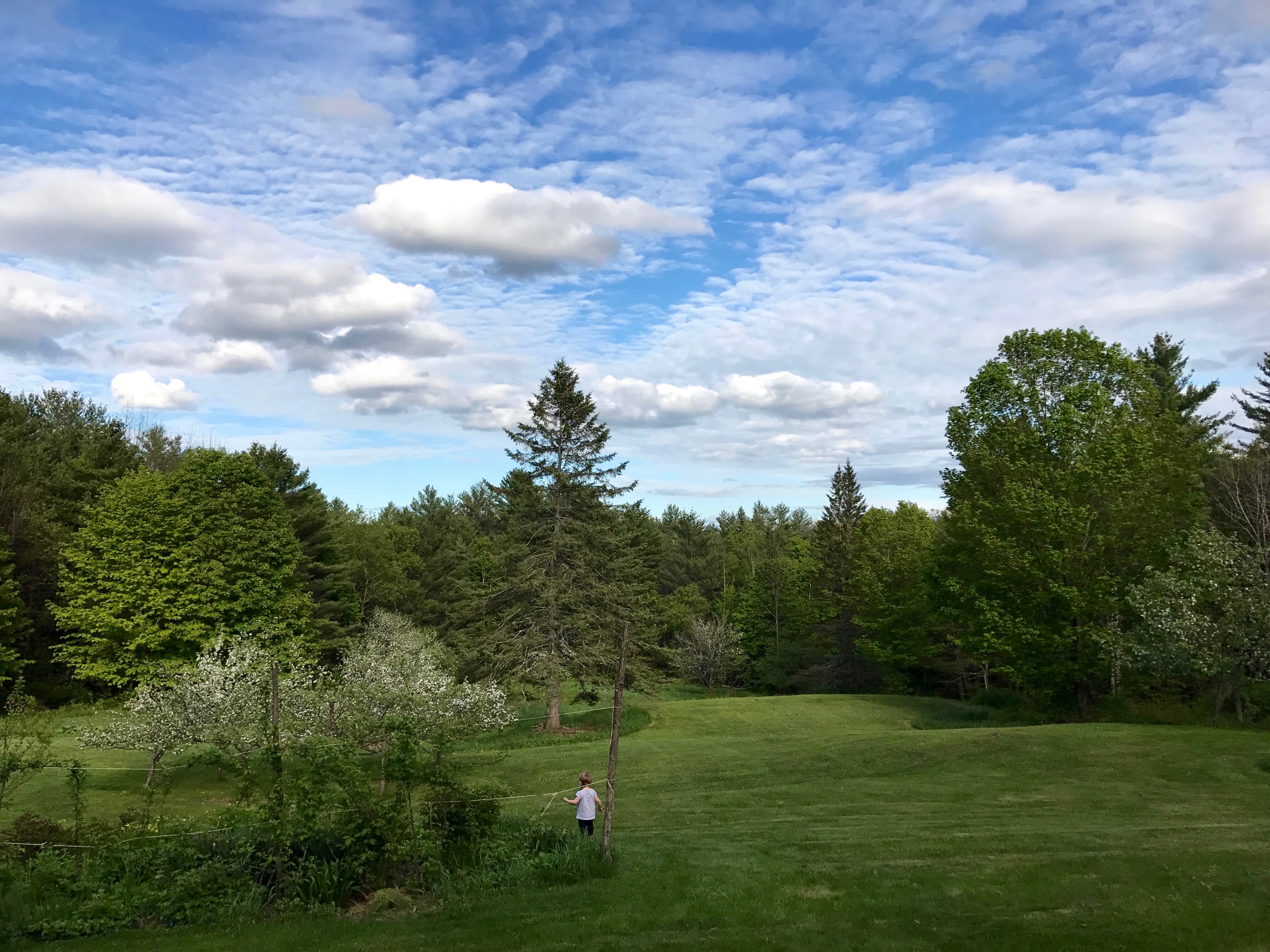
People often ask me what our goal is now that we’ve achieved our ultimate aspiration of a financially independent life on a homestead. But the truth is that we’re still achieving that dream and will be for a long time.
We’re still building our homestead up to where we envision it can be with extensive food production in the form of gardens and perhaps animals, wood working and welding going on in our barn, lots of food preservation happening in the kitchen, Babywoods building forts in the forest, and a labyrinth of blazed hiking trails.
Homesteading is the epitomization of a work in progress and we’re deeply thankful this is the life we’ve signed up for. There’s an almost overwhelming number of things for us to learn, which I try to view as enriching rather than frustrating (my success in this effort varies greatly, let me tell you).

Our selection of Vermont as our permanent home is validated and reinforced on a daily basis through the people, the weather, the ethos, the vibe, the lack of crowds, the absence of rampant consumerism, and the progressive values. We love living here, plain and simple, and we can’t wait for the next 60+ years.
P.S. There are just three days left to sign-up for my Uber Frugal Month Challenge, which we’re taking as a group during the month of July 2017! Join over 16,400 fellow frugal acolytes who’ve taken the Challenge and saved thousands–if not hundreds of thousands–of dollars. For more information on my free 31-day money revamp, check out this post.
P.P.S. Want more homestead pics? Follow me on Instagram where I share a photo of our lives every single day.


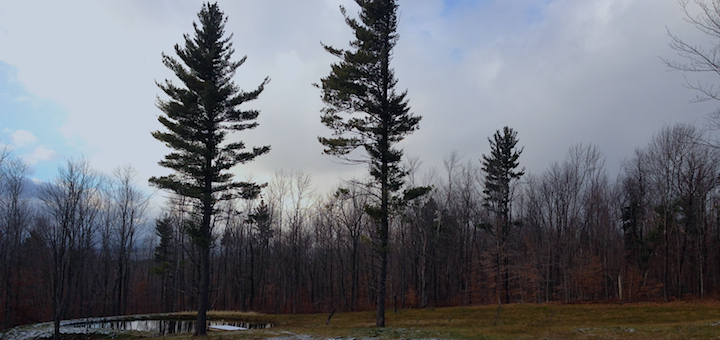
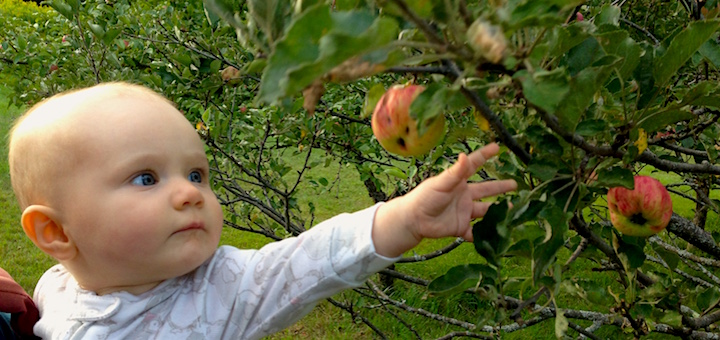
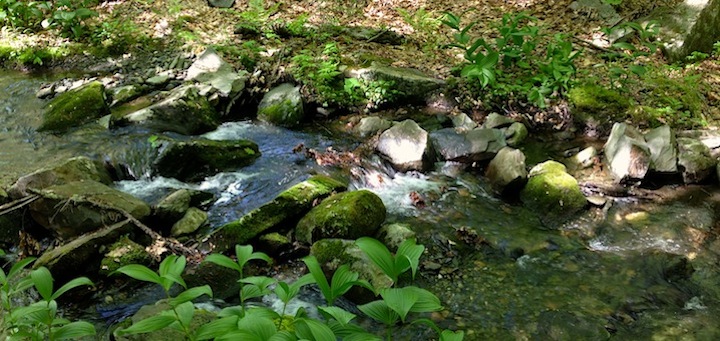
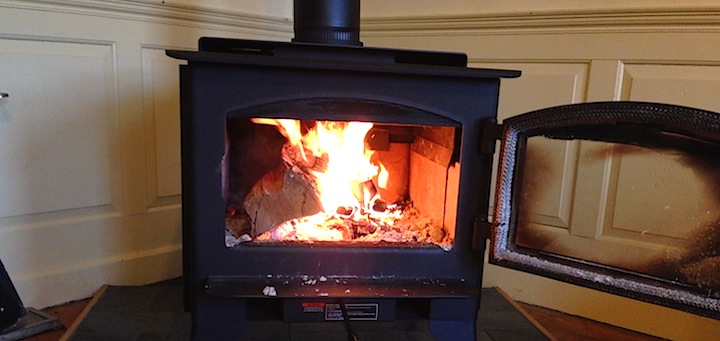
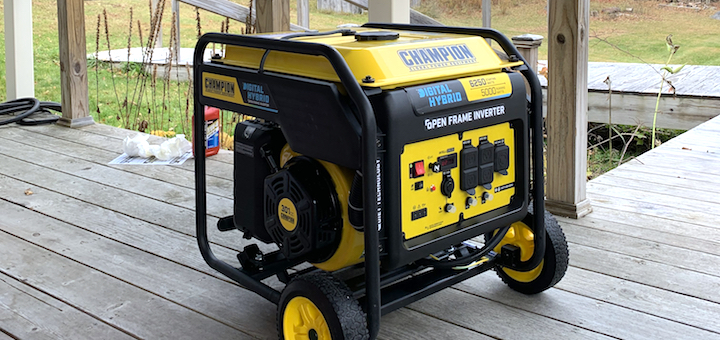
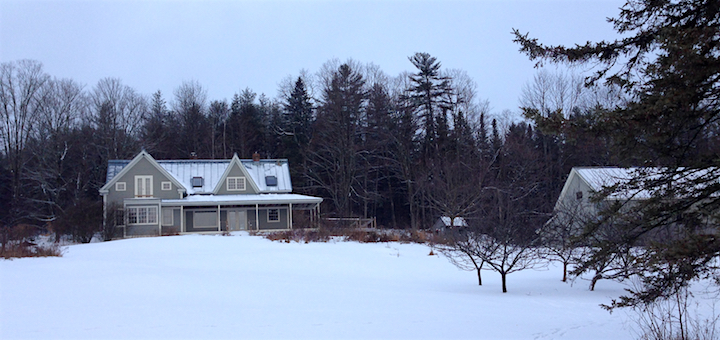
I really liked this post. It gives me closer look at the pros and cons of living in a rural area. I think that the worst moments are worth mentioning since I don’t think I’d enjoy them either. I hate bugs and insects and anything in between. I live in the suburbs, but I get stung by mosquitoes every time I set foot outside, especially in the summer.
That said, it sounds like the pros outweigh the cons, and that both you and Mr. Frugal Woods are enjoying life in Vermont! 🙂
Totally agree here. I love the idea of living a simple, more remote life but the thought of going through some of the “worst moment” do not sound fun to me. Not sure the trade off would be worth it.
Thanks for sharing both side though! Appreciate it.
Ms. Frugal Asian Finance – Check out the Flowtron 1/2 acre bug light (they have it on amazon for like $20). It has changed everything for us during this summer. I have not been bit by a mosquito in a few weeks now and it is wonderful. It is also a lot more cost effective than the sprays they have for the yard that you have to constantly respray.
To all Frugalwoods Fans: I’m glad Counting Quarters has not been bitten and I was considering a bug-zapper until I read the research about these devices. Before you purchase a bug-zapper, please read what scientists say about how they kill mostly beneficial insects. Few of the female mosquitoes (the ones that bite) are caught in these kinds of traps, and most of the insects killed are helpful wasps, beetles, various pollinators and the male (non-biting) mosquitoes.. Widespread use of bug-zappers would create an ecological disaster for songbirds, bats, and other insect-eating wildlife. You can find some information here: https://www.sciencedaily.com/releases/1997/07/970730060806.htm — and there are many other research papers and commentary available online. Please research before putting one of these in your yard. Sometimes we are too quick to find a solution to a pest and do not consider unintended consequences. But do protect yourself! For now, the best bug spray I have found is REPEL, Lemon-Eucalyptus (Deet free); I came across it in Consumer Reports (always trustworthy), which tested a list of natural bug sprays and this one lasts 6 hours as advertised. Given the warming environment, in the future we can expect more mosquitoes that will spread more dangerous diseases; since I am an optimist, I think we can also expect the development of better eradication methods that will target the biting female mosquitoes. But so far the bug-zappers available on the market are (for now) the wrong solution for those of us thinking about the totality of a green environment.
A lovely post (and fabulous photos!) We can’t wait to live such a slow-paced life. There are few things more satisfying that growing your own food. For lunch I’ll be having cucumber and lettuce we grew ourselves. I also find home grown veg makes a great gift (we try not to buy gifts when we can avoid it!) as do homemade chutneys and pickles. People here will pay crazy £££ for ‘local/handmade/organic’ things from local shops. It costs us barely anything to make and friends seem thrilled to receive it.
I don’t know if it’s just an English climate thing, but here apples last for MONTHS if you wrap each one individually in newspaper and store them in a dark shed. You need to make sure there are no bruises on any apple, or they will turn everything else bad. The bruised ones get turned into apple sauce for porridge and cakes. We also exchange what we can’t use. I’ve posted on my local Facebook page and successfully swapped grown veg for other veg, unused seeds and even homemade wine…this was all done in a medium sized urban town 20 minutes outside of London, by the way!
We’re thinking of trying to fashion an outdoor dehydrator out of oven shelves, a couple of old windows and some bricks. It could be a complete disaster, but even so we’ll have had fun and spend no money!
Thanks for another great post, always nice to have a boost of enthusiasm for Frugal Weirdo-ism as I sit at my office desk.
We love the seasons here in MI! It was a huge benefit of moving from southern CA. But I hear you on the purchase needs. Our mere 10 acres required a bit more than we anticipated. Don’t get me wrong, it’s been great… but more than expected!
Yes to purchasing/owning all the things! I am a proponent of minimalism and decluttering of personal items, but it can only go so far. As farmers and owners of 40 acres, who avidly can, craft, and do our own car maintenance, we own so. many. tools, implements, and supplies. It’s a completely different scenario than an apartment-dwelling city life.
So true! The tools needs alone are almost daunting :)!
Great post! Very jealous of all the hiking you’re able to do. Walking around Central Park in the city doesn’t quite cut it. 🙁
Oh man, the idea of being able to press your own cider sounds AMAZING! I would end up drinking it until I made myself sick haha
You’ve talked before about managing your expectations of how much you can get done, but frankly I’m amazed at how much you guys have accomplished out there. I can’t believe you are able to still do your full time computer jobs AND run the homestead AND raise a little one. Definitely impressive.
How fun! There’s definitely a learning curve with homesteading-type tasks. We call our backyard our “burbstead” and have been learning about gardening, raising chickens, keeping bees, and maple sugaring, tending fruit trees, and canning. We have “failed” on just about all these fronts at various points, but we just learn from the mistakes and are sooo grateful that our livelihood does not depend on this stuff. Keeping that in perspective helps us take it in stride, have fun, and enjoy whatever we do produce.
You’ve done so much in just one year’s time! We moved to a very mini farm several years ago, but everything became too much. We went into debt trying to keep up with the messed up water situation and making repairs that we didn’t know about on this home.
Now, all of my farming plans are on hold while we power through all of that debt. I’m really looking forward to getting back to those dreams as soon as the last payment is sent! I just love your stories and pictures here.
I like your honesty in that you admit your dream home comes with cons as well as the many pros — all dreams do, I think. As a former farm girl, I can attest that there are many things on a farm that are less than pleasant — mucking out stalls, killing and cleaning chickens for our consumption, and working outdoors in bad weather come to mind — but I still love the farm life and am working to make a “mini-farm” out of our 1.1 acre out here in the country where we now live. Because you continue to live frugally even after achieving the dream, you can afford to buy the equipment, add the barns, start the gardens, and keep up the house as needed. In no way is frugality deprivation; as so often stated, it is freedom.
Thank you for including the negative list! It actually encouraged me to be reminded that being aware of one’s blessings helps in coping with the inevitable imperfections of anyone’s life. In an effort to encourage others in frugality you might be tempted to don rose colored glasses and present your life as practically perfect but in the end folks would only become discouraged and fall away. Thanks for being honest as well as encouraging!
Sounds like you had a great first year and learned so much! Hurray!
I really get where you’re coming from about being more connected to where your food comes from – I’m also a big proponent of the “locavore” movement. Do you see deer on your property? I’m not sure how carnivorous you and your family are (or how you feel about Bambi…) but 66 acres is plenty of room for deer hunting. Taking 1-2 deer off the property each season could provide many month’s worth of sustainable, lean, organic meat. You could also consider granting property access to someone you trust who hunts, and they would almost certainly share the bounty with you.
You can very easily build your own apple press – we have one that uses a car jack! Works like a charm for us (albeit we don’t have anywhere near the amount of apples you have; I collect them from wild trees in our urban neighbourhood). Making hard cider is very easy, and very satisfying, too. I can recommend The Cider Maker’s Handbook for extremely detailed instructions. Good luck and cheers from the Netherlands:-)
Great post! The bit about not being able to do everything–and being ok with that–resonated especially. Even in my own little house, on a tiny amount of land, I’m always prioritizing and figuring out how to get comfortable with not being able to get it all done when I’d ideally like to.
I really feel you on the veggie garden front – it’s such a miracle when you can grow your own food, but man, it’s not that easy! We are in pretty much the exact opposite type of climate in Southern California, and this year in our garden have dealt with a number of miracles and disappointments. The corn didn’t really turn out…corn-like…but the tomatoes are doing great. And because of the drought, the apricots ripened early with no meat on them. I guess the garden failures just make the successes that much more sweet. 🙂
As someone who wants to ship out of the city to a homestead one day, the honesty in this post is great. I look forward to reading many more installments of your homesteading adventures!
This all sounds utterly amazing, even the bad. One day I would love to grow our own food and have enough to sustain us for the year. Unfortunately living in LA, our land allotment doesn’t help us meet that goal. We are still working towards FI and attempting to nail down the details of what exactly we want to accomplish when we are done. Its so great to hear your experience and also know that it is not just becoming FI and thats it. There’s a lot to continue learning and figuring out even when you are there. Congrats on year 1 and good luck for the years to come!
I can’t believe it’s already been a year! So proud and happy for you. Even though homesteading isn’t my thing (at least not now), I’m in awe of people who work for and achieve their dreams!!
I loved this post! Thank you for sharing the “worst” bits, I think it makes your story much more real 🙂
I think I would struggle with the bugs big time, but perhaps you do acclimatize as one would with the weather!
My hometown isn’t all that far from you folks and boy did this post ever make me miss it! The seasons are totally different here and I miss my networks that I left, especially since my best friend is expecting her first baby. I’m hoping I’ll be able to move back there soon. Keep your fingers crossed for me!
Loving your posts (and looking forward to the uber frugal month). A quick note about the (f—ing) weeds! We’re urban homesteaders and have learned a boatload from Rob Frost (yes, his real name) who blogs here https://onestraw.wordpress.com/ When we moved our gardening systems toward permaculture, we reduced our weeding time ten-fold and our food production went up.
Yard sales and swap meets are how we get all of our tools. When family members were downsizing, my husband said yes to all of the tools and then sold any duplicates at the swap meet to buy what he needed. He really wanted a riding lawn mower so instead of paying $1500 at Lowes for a John Deere, we paid $100 for a 1980s no-name that works fine. My dad’s mower was in the shop for months and he even borrowed it.
We do own too many tools though – my husband hates to borrow them. As a mechanic, many tools go missing if people borrow them so they get possessive. In our friend group, our joke is we only need one of these things to share! We are hoping to get a log splitter with some of our friends – there is no need for more than one.
I live in a zone four area BUT the micro climate at my house says I need to plant for zone three in reality.
Short seasons mean plant for quickly maturing crops.
Fortunately there are good sources for short season seeds.
So cool! It’s fun to read these posts about the homestead and hear what has worked and what hasn’t worked. The journey sounds like hard work, but it has to be so fulfilling.
Loved this post. I am a happy city girl but I love peeking in on your homestead. You have a beautiful life.
I am looking into buying a dehydrator because my love kale chips will ensure it pays for itself. Are you happy with this model? I am wondering if I need one with more trays.
We’re very happy with it thus far!
Love this post. Your contentment in your new(ish) living situation is so clear from the post and it resonates so well with me as I continue to make choices that put me closer to a life of similar contentment. Now if I could only figure out how to have access to hikes like you do on your property without all of the work of living on a homestead, that would be great. 😉
Your land is SO PRETTY in the fall!!! Being from Arizona, fall is my absolute favorite season! We live in North Carolina now, so luckily fall is very pretty here, too!
Looks like a wonderful year! Our goals this year were to work for ourselves again which we achieved. Now, we’re working towards paying off our home. But, life is good and I’m very content with where we’re at. I’m home full-time, and my husband is home often, too. On Monday he had a half-day so we took the girls to the neighborhood pool! Today he’s also off, so we are relaxing and enjoying time as a family! Life is good when you’re out of the hustle and bustle (and expectations) of work ruling your life.
Hope you have a wonderful day!!
-Sarah
Hiking every day right in your own backyard-what a dream! I love this post and especially love that you included the downsides of homesteading. It’s nice to see the bad with the good and it’s a great reminder that contentment is not about having a 100% perfect life. As someone who struggles with feeling like I need to constantly cross things off lists even though most things are self-imposed to-dos, it’s also nice to see how you manage your expectations and not getting everything on your years-long to-do lists done.
Your photos are such a breath of peace and calm and fresh air (as I sit behind a computer!)
Thank you for sharing them.
Honestly your “worst moments” don’t seem all that bad! Living on a homestead could be a far worse experience! Having met many homesteaders in Alaska, your experience seems like a party.
Everyone in your family seems to be healthy, happy, and learning! Congrats!
Following permaculture guidelines has made my garden fairly maintenance free. It definitely takes some experimentation to learn what works in your specific little habitat, but the work up front is well worth the time!
I feel that it also takes a few years to learn which “failures” (I personally think there’s no such thing when it comes to the cycle of Growing; even plants that die are contributing to that ecosystem and I learn more about what my garden “wants”) are consistent and which are just seasonal one-offs – related to odd weather, etc. For example, my plum tree blooms in late April but we’ve had warm temps then a bitter cold snap for two years in a row, so no plums — the first year seemed an anomaly, but now it’s starting to look like a pattern, so I’ll have to amend my process next year by using mason bees or hand-pollinating, for example. Learning how my land, vegetation, and insects/birds relate to one another turns into a map for me to follow.
For myself, things became a lot more “productive” and a lot more satisfying the less I researched and the more I paid attention to what my garden was trying to tell me on its own. But I still look up permaculture and extension articles on the regular, cuz that’s just plain fun on a cold February day 😉
I found poaching tomatoes, skinning and freezing very rewarding. Great for sauce and much better than canned- super easy too.
This week is my one year anniversary of moving from a big city in Southern California to a small town in Missouri. My intention was to lead a more simple life and be near my grandchildren and I’ve done pretty well.
But, I was beating myself up for all the things I bought the first year. Yard stuff for my lawn and trees including an edger trimmer I may never use again. I also went crazy shopping as I prepared for winter and bought a lot of clothes that just weren’t right for me or the materials were shrunk and pilled right away. I bought 3 jackets. We ended up having a mild winter, but I’m sure the snow shovel, ice scraper, and cleats that go over my shoes will come in handy someday. There have also been unexpected plumbing issues and an episode of fleas that kept me from being uber frugal.
As I read your post I feel much better. It feels like this transition is more normal and I can be easy on myself for some of the things I bought. This year I will know what to expect, what clothes last and keep me warm.if I end up needing any, and I will be more relaxed as I get to enjoy the seasons for the second time in my life.
If you’re interested in making your own apple grinder and cider press, this guy has put together some rather comprehensive plans on how to DIY both of them: http://whizbangcider2.blogspot.com/
I read through it the other day and it looked like a fun project, but since we don’t have apple trees in our backyard I couldn’t quite justify the time investment in making them.
Your homestead looks amazing, almost idyllic. How long did it take you to find this place? Did you look long?
This is something I’d love to do but my wife isn’t quite on board. We’ve settled on a happy median. We have a huge lot in our city. Its 60ft by 190ft whereas new homes are on lots 30ft by 100ft at most, so we have about 4 times the space. The goal is to make it as productive as possible. Like you our first year of gardening was mediocre but we’re working on it.
Thanks for the post. It was a fun read!
Thank you. Really enjoyed this post. I enjoyed the honest reflection.
I just knew you both would love Vermont and your homestead. And I deeply appreciate your honesty about the cons. You may remember that I’m an out-of-state city girl moved to Vermont also, and I so completely relate to all you’ve said. A biggie for me was getting used to the lack of consumerism, which has been a pleasant surprise. At first, I missed all the stores, but now if I have to shop I get hives. No one here cares what you wear or what brand is on your clothes. If any thing, people buy brands for their durability (Carhartt) and not fashion. I’ve tried gardening but gave up because I can’t fight the deer who seem to know our work schedule better than us. One of the best things also for me was the beautiful change of seasons, each making no apology for what they bring and represent. Being in touch with nature has healed my previously broken soul. Liz, I tried for years to get well, so to speak, but I just couldn’t find it in the busy pace of the city. Moving here… being in nature, away from the chaos, in tune with the seasons, slowing down dramatically, healed me like I never thought could happen. I am forever grateful for this. I’m so happy you love Vermont, and I wish you all continued success in your plans. They take time….it took several years for me….but it’s well worth it. I love reading your blog and looking at your sweet baby pics. You’re both to be commended, and I’ve learned a lot from you.
I find reading about your slow paced life far away from the city soothing. I don’t want it for myself, but reading posts like this is a little like listening to a lullaby (though I bet Mr. Frugalwoods did not find the wasp sting or plowing the snow over and over particularly soothing). You and your family seem so content. I am happy for you and wish you many more fruitful years of homesteading.
It’s amazing. Living in a house on 66 acres requires a lot of hard work, but the joy of it is priceless.
I still haven’t decided where I want to live when I grow up (I am 57)…lol. All kidding aside, I love your posts, but especially love them since you now have a rural life because I am a country gal at heart! Love your pro and con list. We have loads of bugs, poisonious snakes, alligators, etc. so yes, I totally understand the need to be cautious when outside in a rural area..
I misspelled poisonous……sigh
On the apples: you didn’t mention applesauce. My grandparents had a yellow duchess apple, the fruit was a bit mealy, early, and but made great applesauce. Applesauce cans very well and was common as a side dish with dinner when I was a kid (admittedly it would run a bit and get my bread soggy, but you learn to plan for it).
In that vein: fruit leather.
Google says there’s no such thing as a Yellow Duchess. Based on pictures I think they were Yellow Transparent apples. Take my advice to make applesauce with a grain of salt, the descriptions of the Yellow Transparent fruit and the Red Duchess fruit are very different.
Yep, we have Red Duchess apples and we love the dried fruit we made from them–definitely planning to dehydrate a bunch again this year 🙂
My aunt lives in rural New England as well and she rarely has any ticks on her property. For one thing, she has chickens that free range during the day. (She keeps one rooster around as protection and just deals with the fact that 90% of their eggs are fertilized. They don’t taste any different.) So the chickens not only eat the nasty bugs, they also produce eggs and fantastic fertilizer.
The second reason is because she has a bat house. The bats eat both mosquitoes and ticks. Might I interest you in setting up a bathouse or three? (http://www.humanesociety.org/animals/bats/tips/bat_habitat_bat_houses.html?referrer=https://www.google.com/) The bat guano also makes an amazing fertilizer (I think it needs to be composted first?)
Last, dragonflies. They’ve got a swampy area nearby so the dragonflies, again, eat both mosquitoes and ticks. I suggest looking into ways to make your pond more dragonfly-friendly. With a little one around, you can’t be too careful about the ticks!
To add to that- guinea fowl! Give them a small shelter with a roost, a place to get water, and let them free range. They LOVE mosquitoes and ticks, and they’ll even eat the slugs and aphids that like to attack your garden (just be aware that they may also eat your garden if you let them!)
I absolutely adore your stories about the farm. Even though I have zero interest in following your path thank you for sharing your journey and giving wisdoms how frugality can help accomplish your dreams.
It’s great to hear about your triumphs and challenges on the ol’ homestead. 🙂 We became home owners ourselves almost a year ago (!) and we were also shocked at how much stuff we had to buy to run a household. Blehh! But I do agree that growing our own food seems like such a miracle! I also love the autonomy we’ve had on our own property. 🙂
Love Babywoods in the Fall leaves….she sure has lots of room to roam around…..you guys need more little Babywoods……:)
My son is going to school at the University of Vermont this fall and we are looking forward to spending more time there and not to see him – as he wouldn’t really appreciate that 😉 You make some really interesting points about how much you had to buy that you didn’t expect living in a rural area. It is amazing what you can find to buy used though! And we’ve had tools for 20+ years – so once they’re bought, that expense is over. I wondered if you would mention ticks. I have a peer with Lyme Disease and it has really been life changing. I think that everyone is more aware of ticks now, but I’m guessing that wasn’t something you thought too hard about before you moved. It would never change my mind about living in a beautiful area like yours, but another thing to manage along the way.
I’d love to hear about your trailblazing efforts, that sounds really cool! How does mr. Fw decide where to put trails?
I simply like your post. Thank you for sharing your journey. It is very inspiring and honest.
What a wonderful post! Since you’re a bit woeful over the gardening, I’m wondering if the following might be of assistance to you. . . ?
I’m a passionate gardener of over 30 years and grow most of my own veggies for canning/freezing/root cellaring and year-round use. I have literally hundreds of gardening books, but one taught me more about producing abundant food easily in my cold (northern Montana!) climate than any other, and it was written by a Vermont master gardener (Dick Raymond, who worked for Troy-Bilt for years). Any of his books are great, but “Joy of Gardening” is wonderful if you are serious about producing lots of food in a cold zone. It’s hard to produce enough for winter stockpiling if you do the smaller raised bed methods that so many do these days (unless you have amazing soil and keep it this way). This book taught me to seriously garden for food preservation. The Victory Garden Cookbook is also a wonderful veggie cookbook and makes a great gardening companion.
Re the dried apples. . . If your freezer space gets thin, we always just kept our dried fruit in the pantry–dried food typically lasts for months, though it may darken a bit. For those early apples. . . my neighbor had a Duchess apple tree and I coveted those apples, as I evolved a wonderful and easy way to preserve them for a winter treat–you can make freezer apple dumplings. Divide one regular pie crust (homemade, of course, if you’re frugal! but you could use pre-made) and divide it into five lumps. Roll each into a 6″ or so approx. circle. For each circle, core (no need to peel) one Duchess apple and set it on the crust. Stuff a little brown & white sugar (1 T?), soft butter (1 tsp?) and a dusting of cinnamon/nutmeg into each cored hole. Bring crust up around apple and pinch to close at top. Freeze on a tray or cookie sheet until solid (I usually do about 3 dozen each winter) and then put into a Ziploc bag(s). When you want to eat them, pull however many you want out of freezer and while still frozen, follow Betty Crocker homemade apple dumpling instructions for syrup and baking (which you can do in a jiffy. Delicious on a cold winter day–it’s like a personal apple pie only no work– and people will think you are brilliant!
https://www.bettycrocker.com/recipes/apple-dumplings/6907c45f-62d0-4bc7-a958-25d8c6013f2e
For a great frugal pie crust recipe, my recipe is like this one, only I use regular flour and regular Crisco. I divide it into 16 crusts so it fits my bigger pans, and freeze them. When I am ready to make dumplings, I thaw however many crusts I need, knowing that each of them divides into 5-6 dumpling crusts.
http://www.nuttnhoney.net/KimsKitchen/20FreezerPieCrusts.html
Hope this helps. . .
Best,
Anne
Love this post also! Since you get so many apples and clean with vinegar, will you be making your own apple cider vinegar this year?
It’s very simple and you can use your apple cores/scraps. Theres so many uses.
I would never want to leave your homestead either! It’s beautiful, warm and very homey and cozy. Your posts transport me.
Yes! Apple cider vinegar is definitely on the potential to make list this fall :). Do you have a recipe you like?
I just love the photography from your property. You have some breathtaking views there! My husband and I would like to end up in Vermont someday as well. We’re in NC now and most of our work is in the south and seasonal (Summer) so it seems endlessly hot and humid. We like to daydream of cooler climes while we sweat. 🙂
I sway back and forth everyday between needing the City life, vs wanting to leave it as soon as possible. I’d love to slow down. We’re in Texas right now (in a rapidly growing – but already sprawled out city). My biggest challenge is to first get my husband to realize that there is life outside of Texas. Life, and seasons! I absolutely crave four seasons. PS, I’m also terrified of Ticks.
During the last year we have been reflecting about “Learning how to say no and manage our time.” In three more years we plan to do a transition to a small ranch (2.5 acres) in our home country. We realized how the timing and the learning curve is different from our life in an urban area.
Our first goal is to build the homestead from scratch with bioconstruction practices, superadobe, green roof, solar energy, water management. We plan to be full dedicated to this process. There is no financing to non conventional construction in our country. So we have been saving to pay in cash.
Beaultiful post! You did a lot in a year.
I don’t know if you are aware of the following people whose knowledge can help with your gardening. The first is:
http://www.onestrawrevolution.net/One_Straw_Revolution/Massanobu_Fukuoka.html
http://www.motherearthnews.com/organic-gardening/ruth-stouts-system-zmaz04fmzsel
http://www.nytimes.com/2012/02/23/garden/living-off-the-land-in-maine-even-in-winter.html
IMO, the absolute best way to garden is “going with the land” and not trying to control it. So, heavy mulching, adding large amounts of compost, drip irrigation, and a greenhouse for winter will produce the best and easiest results. Many people have this notion that the land needs to be tilled and weeded. That’s a completely inefficient notion not to mention it destroys vital microbial life so essential to healthy soil (which is the root of all healthy food.) Creating a food forest using permaculture methods which incorporate perennial vegetables (ie; asparagus) can result in a tremendous amount of food as well. Finally, the garden will be a source of food for a certain amount of critters and insects. Using these methods will provide more than enough food for all. Best of luck.
We have that dehydrator as well and it works great for our needs. The Frugal Girl blog has a great freezable applesauce recipe that may work for you with all those apples! Great post!!
Such beautiful pictures! Do you have a post to detailing your income and how you guys are making a living off the grid? I really like the simplicity of your lives. It is quite wonderful.
Thx,
Sam
Congratulations on your homestead-iversary! I’m definitely impressed by you guys making such a huge change, especially with no prior rural living experience! We recently moved to a place with 1.3 acres, and that seems like enough work for us for sure! We love the added privacy and the majestic trees surrounding us! Keep the homestead pictures coming!
I keep looking at the pictures of your yard and I all can think is over there is where I’d put the tee box, that would be the fairway, there’s a natural bunker, the and bridge is already in place for the green to go just over the water hazard.
Pretty.
One word: Squeezo. Try to find a used 1980s Squeezo on Ebay, it was invaluable when I was doing a lot of canning. It makes fantastic applesauce!!
Congratulations on your anniversary! It is obvious you’ve found your place.
Hi! Longtime reader but first time commenter. I am curious about ethnic and socioeconomic diversity where you live now. We are in the early phases of considering a rural move but diversity is very important to us as we want our children exposed to diversity. Any comments on this?
This is a great question and it’s one we considered as well since we lived in very diverse urban areas prior to moving out here. The short answer is that we have a great deal of socioeconomic diversity here (and in her school), but not much ethnic diversity at all, which is a downside. To combat this, we plan to incorporate books and education on diversity for our daughter and also take relatively frequent trips to the big cities (we’re easy driving distance to NYC and Boston) as she gets older in order to expose her to different styles of living. This is one of the reasons why we chose Vermont–the ease of getting to big cities is important to us so that our daughter has consistent exposure to modes other than rural. There’s also a lot of arts and culture in our area, which was another advantage of Vermont, in addition to the progressive ethos of the state and our community. In short, nowhere is perfect, but we’re aware of the shortcomings of our area and will do our best to provide our daughter with a well-rounded, inclusive upbringing.
Jody is right about Sqeezo! We bought our Original Squeezo Strainer (made in Burlington, Vermont) and it is a necessity. We also put a small bowl to catch the juices. All that is left is small amount with seeds and skins since we push that through a second time to get every last bit. One hint is to do this outside because it can be messy. We improvised our porch railing with a 1×4 for this project. Oh…every bee in the neighborhood shows up but we don’t let their “buzzing” stop us. Not 1 bee sting yet! Yea!
This was a wonderful post–as always! Thank you Liz for the generosity of your fine writing and for sharing your stories—and greetings to all the Frugalwoods Community for ideas and helpful links to gardening lore posted in this thread. As one who gardened in Colorado in my teen years because I was inspired by Rodale Press Organic Gardening Magazine (when it was still published on newsprint), I lived in Manhattan for 30 years with window boxes. Now we are Upstate with a garden. When we moved here, the clay glacial soil was thin, hard, choked with weeds. For the past 14 years we have fed it with every appropriate scrap from our kitchen and grass clippings from our chemical-free lawn; now It teems with earthworms. Black gold indeed. The longer one gardens, the more one becomes completely consumed by and concerned with the soil. What grows becomes almost a by-product of the amazing complexity of the living topsoil, just as robust health becomes a by-product of good daily habits over time. The cycle of putting organic matter back into the earth and reaping the rewards in future years is a metaphor for the simplicity of living the Good Life (yes, thanks Scott & Helen Nearing and all the other inspiring organic gardeners who have shared experiences and expertise). Even at this stage I call myself a Baby Gardener—there is always so much more to learn and share with fellow gardeners.
If you get a glut of tomatoes (or even a couple of days to “too many”) and don’t want to can them, either dehydrate or freeze. You can just wash, dry and freeze without any other prep. When you defrost them the skins will just slip off. When I dehydrate I also keep in the freezer so I don’t worry about getting every drop of moisture out.
If you don’t already, I suggest keeping a garden log. When I started gardening I kept a weekly log outlining what I planted including variety and notes about weather, bugs, what was growing well or not, etc. I kept a separate section where I logged daily what I picked and poundage. You think you’ll remember year to year but you won’t.
Hey, I’m just finding out about your story now, but it sounds amazing! I love hiking, and sometimes when I’m out I imagine what it’d be like leaving everything behind and living ‘off-grid’. 🙂
It’s a beautiful place u have got. The beauty of nature is unbelievable. Pictures look like they should be on postcard. Love it.
i live a long way from where you live. yet i am fascinated by all the things you are doing at your new farm.
please keep up the good works, thanks.
Great post!
FI Newbie here! I wish you good luck with your next year on the homestead. Great job of getting to this point. I am very envious and motivated at the same time. I wish to have my own homestead someday!
I like how you keep it real and share some of the challenges as well as the benefits of the homestead lifestyle. So many websites seem to be selling ‘the dream’ without addressing the reality. Thank you for being honest and showing both sides of the equation.
SO happy to have found your blog! We have been focused on frugal living for years and just purchased a 65 acre mostly wooded property with an old stone farmhouse in Pennsylvania. I look forward to pouring through your articles for tips and ideas.
it can be tough for flatlanders to adapt at first. i grew up 0.25 miles from the vermont border near lake champlain and worked a couple of summers for the vermont highway crew. despite my proximity i was still a flatlander. you’ll figure it out. friend of mine is now making a root cellar to keep his apples fresh in the winter, along with tater and onions.
I was wondering if there is a notebook or planner you use for organizing all your plans on the property. We are moving to the country from the city in a few months and have so many ideas, but really need to get them all down on paper (or computer) so we can plan wisely. Any recommendations? Thanks!
We tend to use Google docs for everything–it’s free and online!
This is a great post. My husband and i are now starting to get on the same page with FI and your blogs have hit home to a lot of our own ways of living. We are 27 with a 1 year old and we have 6 acres of land. Trying to live simply and enjoy time with our son! Any recommendations/tips on finding good deals doe tractors/ large lawnmower?